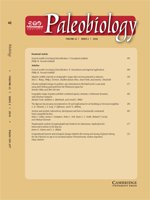We explore the relationships among the geographic ranges of genera, the ranges and positions of their constituent species, and the number of species they contain, considering variation among coeval genera and changes within genera over time. Measuring range size as the maximal distance, or extent, between occurrences within a taxon, we find that the range of the most widespread species is a good predictor of the range of the genus, and that the number of species is a better predictor still. This analysis is complicated by a forced correlation: the range of a genus must be at least as large as that of each of its constituent species. We therefore focus on a second measure of range, the mean squared distance, or dispersion, of occurrences from the geographic centroid, which, by analogy to the analysis of variance, allows the total dispersion of a genus to be compared to the mean within-species dispersion and the dispersion among species centroids. We find that among-species dispersion is the principal determinant of genus dispersion. Within-species dispersion also plays a major role. The role of species richness is relatively small. Our results are not artifacts of temporal variation in the geographic breadth of sampled data. The relationship between changes in genus dispersion and changes in within- and among-species dispersion shows a symmetry, being similar in cases when the genus range is expanding and when it is contracting. We also show that genera with greater dispersion have greater extinction resistance, but that within- and among-species dispersion are not demonstrable predictors of survival once the dispersion of the genus is accounted for. Thus it is the range of the genus, rather than how it is attained, that is most relevant to its fate. Species richness is also a clear predictor of survival, beyond its effects on geographic range.
How to translate text using browser tools
9 March 2016
Geographic ranges of genera and their constituent species: structure, evolutionary dynamics, and extinction resistance
Michael Foote,
Kathleen A. Ritterbush,
Arnold I. Miller
ACCESS THE FULL ARTICLE

Paleobiology
Vol. 42 • No. 2
Spring 2016
Vol. 42 • No. 2
Spring 2016




